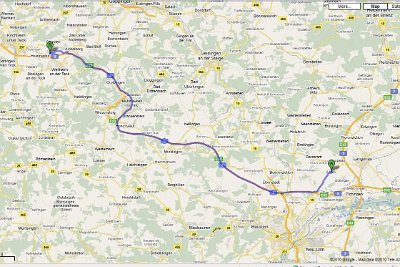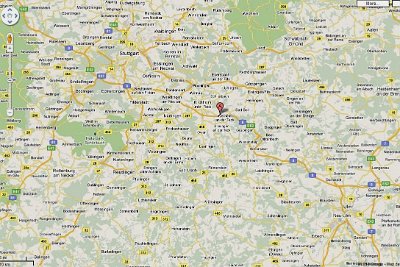 1 Thursday 15 July, 2010 When we awoke this morning we had a nice surprise: Claus had got up early, set the table and made breakfast for us. Jenni was very touched. |
 2 Thursday 15 July, 2010 Today, our last day with Claus, we decided to go to Holzmaden, a distance of 55kms kms from Claus' place in Langenau-Albeck (north of Ulm). Ulm is just over the Bavarian border in the state of Baden-Wurttemberg. |
 3 Thursday 15 July, 2010 To get a better idea of where Holzmaden is, it's roughly in the middle between Ulm and Stuttgart in the western part of Southern Germany. |
 4 Thursday 15 July, 2010 Our reason for going to Holzmaden was to visit the Urwelt-Museum Hauff (Urwelt = primeval world). The museum was built in 1936/37 from the private collection of taxidermist Bernhard Hauff. |
 5 Thursday 15 July, 2010 During the Jurassic period most of Europe was under the Jurassic Sea. The Jurassic was the period from 199 Mya to 145 Mya (i.e. between the Triassic and the Cretaceous periods). |
 6 Thursday 15 July, 2010 From the museum's web site: "180 million years ago, Europe was almost completely covered by the Jurassic Sea. Present-day southern Germany was then a shallow sea basin at the edge of the Tethys Sea and the exceptional preservation of the fossils is due to the following factors:
|
 7 Thursday 15 July, 2010 The bottom of the sea was covered in anoxic (no oxygen) mud and this was perfect for preserving the flora and fauna that died in it. The mud later turned into shale and the fossils reside in layers of shale called the Swabian Jura (plural) meaning Swabia during the three Jurassic periods. The Jurassic Period is divided into Early Jurassic, Middle, and Late Jurassic epochs. |
 8 Thursday 15 July, 2010 The Swabian Jura is made up of strata from the Lower, Middle and Upper Jurassic periods. During the Lower Jurassic, today's fossil site at Holzmaden was approximately 150 kilometers away from the nearest coast. |
 9 Thursday 15 July, 2010 The layers are 600-700 metres deep and were created between 190 and 130 million years ago at the bed of the Jurassic Sea and were elevated later. This is a marine crocodile. |
 10 Thursday 15 July, 2010 The ichthyosaurs (ichthys = fish, saura = lizard) are the most frequently and best studied reptiles of the Jurassic. The longest known specimens measured up to 18 metres in length (this one is 4 metres long). Their ancestors were saurians (lizard ancestors) living on land. |
 11 Thursday 15 July, 2010 All ichthyosaurs, including the earliest, had fin-like limbs. In adapting to the aquatic environment the limbs changed over time. The bones of the forelimbs shortened and widened as a result of evolutionary changes |
 12 Thursday 15 July, 2010 Being reptiles they constantly had to swim to the surface to breathe. |
 13 Thursday 15 July, 2010 The first complete skeleton of an ichthyosaur was found in 1811 when dinosaurs were still unknown. The fossils confused people (experts that is), because their structure vaguely resembled that of terrestrial vertebrates . They were initially held by some researchers to be fish while others saw them as amphibians and even mammals. |
 14 Thursday 15 July, 2010 A Fossilised crocodile found in the Holzmaden quarries. All fossils in the museum were found within the past 100 years. |
 15 Thursday 15 July, 2010 Steneosaurus is an extinct marine crocodilian. |
 16 Thursday 15 July, 2010 During the Mesozoic Era (which includes the Jurassic), a fundamental change occurred in bony fish. More advanced, skilled predatory fish gained the upper hand over primitive fish like this one which had an armour of thick, bony scales reinforced by a shiny enamel layer. |
 17 Thursday 15 July, 2010 Fossilised water lillies found in the Holzmaden quarries. |
 18 Thursday 15 July, 2010 Because the mud into which they sank contained no oxygen, they were beautifully preserved. |
 19 Thursday 15 July, 2010 Behind me is the world's largest petrified crinoid (sea lily) colony with a size of 18 × 6 m and an age of about 180 million years. Behind Claus are more fossilised lillies |
 20 Thursday 15 July, 2010 Closeup of the fossilised water lillies behind me. |
 21 Thursday 15 July, 2010 Tyranosaurus Rex didn't exist at the time the Jurassic sea covered Holzmaden. It lived for a short period between 68 to 65 million years ago during the Cretaceous period. The Cretaceous period ended with a mass extinction event when dinosaurs and 75% of all living things died. |
 22 Thursday 15 July, 2010 The mass extinction of 65 Mya was the most "recent" after which mammals and birds predominated. There have been five mass extinctions in the past 540 million years. |
 23 Thursday 15 July, 2010 Claus points out to Jenni how to tell a boy dinosaur from a girl dinosaur. |
 24 Thursday 15 July, 2010 An old picture hangs in the museum that shows the Holzmaden shale quarries being searched for fossils. |
 25 Thursday 15 July, 2010 This quarry was just across the street from the museum and school children, armed with small picks, opened up pieces of shale to reveal the treasures hidden within. The amazing thing is that this was mud at the bottom of a sea 130 million years ago. |
 26 Thursday 15 July, 2010 Claus and Jenni leave the quarry empty-handed. Next stop: the Hohenneuffen castle |